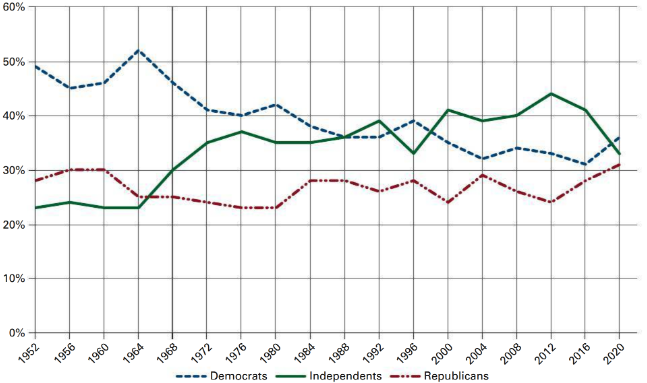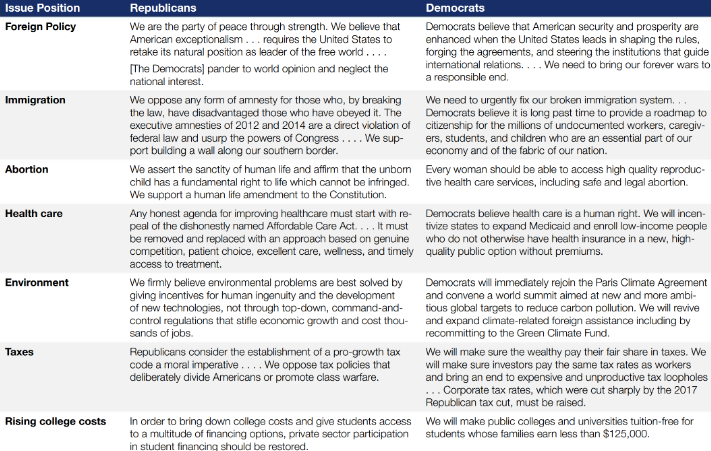Unit 4 & 5- Chapter 8
Party Polarization: The growing gap between the stands of the parties on policy issues. On the negative side, polarization makes compromise more difficult, whereas on the positive side, clear differences between the parties make politics easier to understand for voters.
THE MEANING OF PARTY
Party competition is the battle between Democrats and Republicans for the control of public offices. Without this competition there would be no choice, and without choice there would be no democracy.
Political Party: In the words of economist Anthony Downs, a “team of [people] seeking
to control the governing apparatus by gaining office in a duly constituted election.”
“Three-headed political giants”: The three heads are (1) the party in the electorate, (2) the party as an organization, and (3) the party in government.
The party in the electorate is by far the largest component of an American political party.
To be a member of a party, you need only claim to be a member
The party as an organization has a national office, a full-time staff, rules and bylaws, and budgets. In addition to its national office, each party maintains state and local headquarters.
Its members keep the party running between elections and make its rules.
The party in government consists of elected officials who call themselves members of the party.
These leaders are the main spokespersons for the party.
TASKS OF THE PARTIES
Linkage institutions: The channels through which people’s concerns become political issues on the government’s policy agenda. In the United States, linkage institutions include elections, political parties, interest groups, and the media.
In the United States, there are four main linkage institutions: parties, elections, interest groups, and the media.
Picking Candidates: A party’s official endorsement is called a nomination; it entitles the nominee to be listed on the general election ballot as that party’s candidate for a particular office
Running Campaigns: Through their national, state, and local organizations, parties coordinate, political campaigns. However, television and the Internet take candidates’ cases directly to the people without the aid of the party organization.
Articulating Policies: Each political party advocates specific policy alternatives.
Coordinating Policymaking: In America’s fragmented government, parties are essential for coordinating policymaking between the executive and legislative branches.
WHY IT MATTERS TODAY - POLITICAL PARTIES
Parties perform many important tasks in American politics. Among the most important are generating symbols of identification and loyalty, mobilizing majorities in the electorate and in government, recruiting political leaders, implementing policies, and fostering stability in government. Hence, it has often been argued that the party system has to work well for the government to work well.
PARTIES, VOTERS, AND POLICY: THE DOWNS MODEL
Rational-Choice Theory: A popular theory in political science to explain the actions of voters as well as politicians. It assumes that individuals act in their own best interest, carefully weighing the costs and benefits of possible alternatives.
Downs argues that (1) voters want to maximize the chance that policies they favor will
be adopted by government and (2) parties want to win offices.
THE DOWNS MODEL: HOW RATIONAL PARTIES POSITION THEMSELVES NEAR (BUT NOT AT) THE CENTER OF PUBLIC OPINION
The American National Election Studies regularly asks a sample of the American population to classify themselves on a 7-point scale from extremely liberal to extremely conservative. As illustrated in the four graphs below, both political parties regularly face the challenge of positioning themselves relatively close to the median voter, in particular to appeal to Independents, while at the same time being responsive to the position of their own base of supporters.
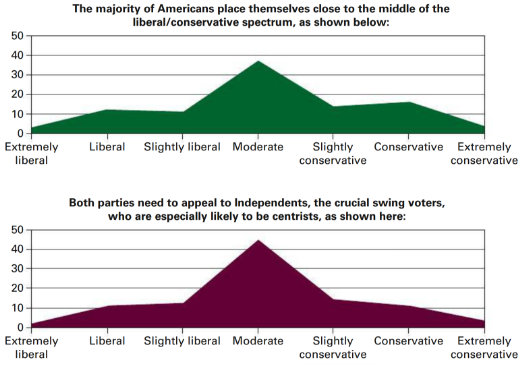

In the American electorate, a few voters are extremely liberal and a few are extremely conservative, but the majority are in the middle or lean just slightly one way or the other.
Key-swing voters: Those who identify themselves as being independent of party affiliation.
Independents are very much concentrated near the middle of the liberal–conservative spectrum. Thus, if Downs’s theory is right, then parties must stay fairly near the center in order to broaden their appeal.
THE PARTY IN THE ELECTORATE
If you believe you are a Democrat or a Republican, then you are a Democrat or a Republican. Thus, the party in the electorate consists largely of symbolic images and ideas. For most people, the party is a psychological label.
Party image: The voters’ perception of what the Republicans or Democrats stand for, such as conservatism or liberalism. Party image helps shape people’s party identification.
Party identification: A citizen’s self-proclaimed preference for one party or the other.
PARTY IDENTIFICATION IN THE UNITED STATES
Political analysts and scholars carefully monitor changes in the distribution of party identification. Below, you can see the percentage of the population that has identified itself as Democrats, Independents, and Republicans during each presidential election year from 1952 to 2020.
YOUTHFUL INDEPENDENCE
Data indicate that as people get older, they become more likely to identify with one of the major parties.
Regardless of whether they lean toward one party or the other, Independents are the most likely to engage in the practice of ticket-splitting—voting with one party for one office and the other party for another office.
THE PARTY ORGANIZATIONS: FROM THE GRASS ROOTS TO WASHINGTON
Candidates in the United States can get elected on their own. They do not need the help of the party most of the time, and hence the party organization is relegated to a comparatively limited role.
Party machines: A type of political party organization that relied heavily on material inducements, such as patronage, to win votes and to govern.
Depended on rewarding its members for their loyalty in some material fashion.
Patronage: One of the key inducements used by party machines. A patronage job, promotion, or contract is one that is given for political reasons rather than for merit or competence alone.
50 STATE PARTY SYSTEMS
There are 50 state-party systems, and no two are exactly alike.
In a few states, such as Pennsylvania, the parties are well organized, have sizable staffs, and spend a lot of money.
In other states, such as California, party organizations are weak and underfunded.
The states are allowed wide discretion in the regulation of party activities, and how they choose to organize elections substantially influences the strength of the parties.
Closed primaries: Elections to select party nominees in which only people who have registered in advance with the party can vote for that party’s candidates, thus encouraging greater party loyalty.
Open primaries: Elections to select party nominees in which voters can decide on Election
Day whether they want to participate in the Democratic or Republican contests.
THE NATIONAL PARTY ORGANIZATION
The supreme power within each of the parties is its national convention.
National convention: The meeting of party delegates every four years to choose a presidential
ticket and write the party’s platform.
Keeping the party operating between conventions is the job of the national committee.
National Committee: One of the institutions that keeps the party operating between conventions. The national committee is composed of representatives from the states and territories.
The day-to-day activities of the national party are the responsibility of the party’s national chairperson.
National Chairperson: Hires the staff, raises the money, pays the bills, and attends to the daily duties of the party.
THE PARTY IN GOVERNMENT: PROMISES AND POLICY
What a party has done in office, and what it promises to do, greatly influence who will join its coalition.
Coalition: A group of individuals with a common interest on which every political party
depends.
If parties generally do what they say they will, then the party platforms adopted at the national conventions represent blueprints, however vague, for action.
PARTY PLATFORMS, 2020
Although few people actually read party platforms, they are one of the best-written sources for what the parties believe in. A brief summary of some of the contrasting positions in the Democratic and Republican platforms of 2020 illustrates major differences in beliefs between the two parties. Below you can find some direct quotes from the Republican and Democratic party platforms from 2020, which illustrate many of the major differences in beliefs between the two parties. (It should be noted that the 2020 Republican platform was actually drafted in 2016, and was officially readopted without any changes by the 2020 Republican National Convention)
PARTY ERAS IN AMERICAN HISTORY
A majority of voters identify with the party in power; thus, this party tends to win a majority of the elections. Political scientists call these periods of history party eras.
Critical election: An electoral “earthquake” where new issues emerge, new coalitions replace
old ones, and the majority party is often displaced by the minority party.
Party realignment: The displacement of the majority party by the minority party, usually during a critical election period.
Realignments are typically associated with a major crisis or trauma in the nation’s history.
1796–1824: THE FIRST PARTY SYSTEM
Hamilton was the nation’s first secretary of the treasury. In order to garner congressional support for his policies, particularly a national bank, Hamilton needed votes.
Federalist Party: America’s first political party
Democratic-Republicans: First opposition party
Was largely popular in the South because it derived its coalition from agrarian interests, but was torn apart by factionalism as it tried to be all things to all people.
1828–1856: JACKSON AND THE DEMOCRATS VERSUS THE WHIGS
Democratic Party: Founded by General Andrew Jackson.
Particularly appropriate for Jackson’s supporters because their cause was to broaden political opportunity by eliminating many vestiges of elitism and mobilizing the masses.
Whig Party: Northern industrialists and Southern planters were brought together more by the Democratic policies they opposed than by the issues on which they agreed.
Van Buren argued that a party could not aspire to please all the people all the time. He argued that a governing party needed a loyal opposition to represent parts of society that it could not.
1860-1928: THE TWO REPUBLICAN ERAS
Republican Party: The Republicans rose in the late 1850s as the antislavery party.
The “War Between the States” was one of those political earthquakes that realigned the parties
A second Republican era was initiated with the watershed election of 1896, perhaps
the bitterest battle in American electoral history.
The Republican Party made clear its positions in favor of the gold standard, industrialization, the banks, high tariffs, and the industrial working classes as well as its positions against “radical” Western farmers and “silverites.”
1932-1964: THE NEW DEAL COALITION
President Herbert Hoover’s handling of the Depression turned out to be disastrous for the Republicans.
New Deal Coalition: A coalition forged by the Democrats, who dominated American politics from the 1930s to the 1960s. Its basic elements were the urban working class, ethnic groups, Catholics and Jews, the poor, Southerners, African Americans, and intellectuals.
The New Deal coalition made the Democratic Party the clear majority party for
decades.
PARTY COALITIONS TODAY
The two parties continue to draw support from very different social groups, many of which have existed since the New Deal era. This figure shows the percentage identifying as Democrats and Republicans for various groups in December 2019.
Many of the same groups that supported FDR’s New Deal continue to be part of the Democratic Party’s coalition today.
1968-PRESENT: SOUTHERN REALIGNMENT AND THE ERA OF DIVIDED PARTY GOVERNMENT
Emphasizing his support for states’ rights, law and order, and a strong military posture, Nixon hoped to win over Southern conservatives to the Republican Party, thereby breaking the Democratic Party’s long dominance in the former Confederacy.
REALIGNMENT IN THE SOUTH
One of the most significant political changes over the past four decades has been the partisan realignment in the Southern states that has transformed this region from a solid Democratic base of support to a solid Republican area.Without strong Southern support for the Republicans in recent elections, it is doubtful that the GOP would have been able to attain majority party status in the Congress for the majority of the period from 1995 to 2022.
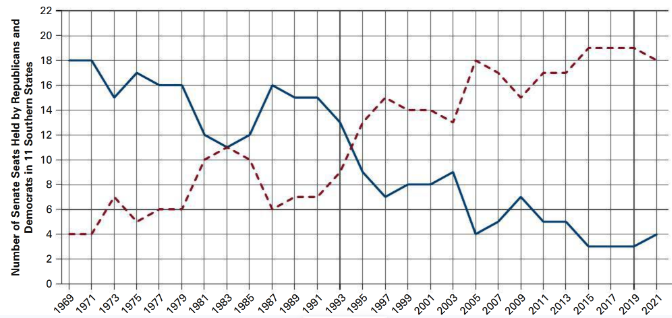
Whereas the Democrats held the vast majority of the South’s Senate seats in the late 1960s and the 1970s, ever since the mid-1990s the Republicans have been the dominant party in the South. This trend is evident in representation in the House of Representatives as well.
WHY IT MATTERS TODAY - DIVIDED PARTY GOVERNMENT
When one party controls the White House and the other party controls one or both houses of Congress, divided party government exists. Given that one party can check the other’s agenda, it is virtually impossible for a party to say what it is going to do and then actually put those policies into effect. This situation is bad if you want clear lines of accountability on policy, but it is good if you prefer that the two parties be forced to work out compromises.
Whereas realignment involves people changing from one party to another, party dealignment means that many people are gradually moving away from both parties.
THIRD PARTIES: THEIR IMPACT ON AMERICAN POLITICS
Third parties: Electoral contenders other than the two major parties. American third parties are not unusual, but they rarely win elections.
They have brought new groups into the electorate and have served as “safety valves” for popular discontent.
Third parties in the United States come in three basic varieties:
Parties that promote certain causes
Splinter parties, or offshoots of a major party
Parties that are merely an extension of a popular individual with presidential aspirations.
Winner-take-all system: An electoral system in which legislative seats are awarded only to the candidates who come in first in their constituencies.
In this way, the American system discourages small parties. Unless a party wins, there is no reward for the votes it gets. Thus, it makes more sense for a small party to merge with one of the major parties than to struggle on its own with little hope.
Proportional representation: An electoral system used throughout most of Europe that awards legislative seats to political parties in proportion to the number of votes won in an election.
Merging would not be necessary, as even a small party can use its voice in Parliament to be a thorn in the side of the government, standing up strongly for its principles.
Coalition government: When two or more parties join together to form a majority in a national legislature. This form of government is quite common in the multiparty systems of Europe.
UNDERSTANDING POLITICAL PARTIES
Responsible party model: A view about how parties should work, held by some political scientists. According to the model, parties should offer clear choices to the voters and once in office, should carry out their campaign promises.
Advocates of the responsible party model believe the parties should meet the following conditions:
Parties must present distinct, comprehensive programs for governing the nation.
Each party’s candidates must be committed to its program and have the internal
cohesion and discipline to carry out its program
The majority party must implement its programs, and the minority party must
state what it would do if it were in power.
The majority party must accept responsibility for the performance of the government.
A two-party system operating under these conditions would make it easier to convert party promises into government policy.
PARTISAN DIVISIONS ON KEY ROLL CALL VOTES DURING THE OBAMA PRESIDENCY
During the presidency of Barack Obama, there was much discussion in the press about heightened partisan tensions between Democrats and Republicans in Congress. A close look at votes in the House of Representatives on major legislation that President Obama signed into law reveals three patterns: Democrats and Republicans sometimes differ greatly, sometimes cooperate, and sometimes oppose their own party’s president more than the other party.
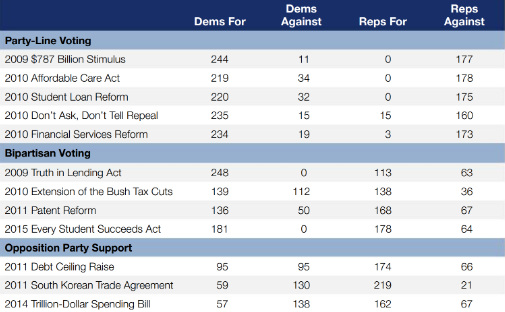
As a rule, when the party line conflicts with legislators’ own personal opinions and/or the clear desires of their constituents, they feel comfortable voting against their party’s leaders’ wishes.
Many people believe that the gap between the two parties has become so wide that it is hard to get bipartisan agreement about anything.
On the other hand, because it is rarely the case that one single party can ever be said to have firm control over American government, the hard choices necessary to cut back on existing government spending are rarely addressed.
